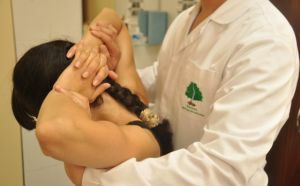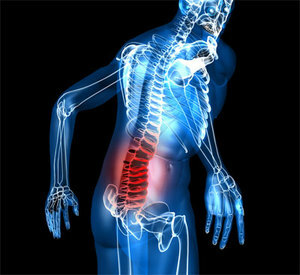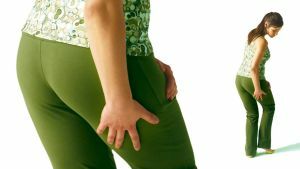 The sciatic nerve is the longest nerve in the human body. And is it worth to say, what kind of unpleasant sensations does he give with neuralgia, neuritis or inflammation?
The sciatic nerve is the longest nerve in the human body. And is it worth to say, what kind of unpleasant sensations does he give with neuralgia, neuritis or inflammation?
Inflammatory process or scientifically sciatica is an unpleasant condition, during which severe pain from the waist region and to the back of the thigh is disturbed. As a result, discomfort occurs during walking and other motor functions.
Neuralgia of the sciatic nerve or vertebrogenic sciatica is a disease that is accompanied by an inflammatory process and a pinch of the sciatic nerve. These disorders are caused by mechanical irritations or viral infectious lesions.
The sciatic nerve is very long, compared with other nerve endings, it is considered the longest.
The length of this nerve covers the beginning of the lumbar region and ends with the lower limbs. The entire area of the sciatic nerve has numerous branches in the form of small nerve endings, so inflammation causes pain in different parts of the body.
Contents
- Anatomy of the sciatic nerve
- Causes and triggers of sciatica
- Features of the clinical picture
- Symptoms of lumbago with sciatica
- Diagnosis of
- Provision of medical care
- What can be done at home?
- Prophylactic measures
Anatomy of the sciatic nerve
The sciatic nerve consists of several layers: 
- The inner layer is the endonurium .It consists of a whole network of capillary vessels.
- Middle layer - perineurium .This layer is the enveloping layer of the entire sciatic nerve. In this nerve are large vessels that have a coating in the form of loose connective tissue. This fabric serves as a kind of pillow.
- Outer layer - membrane, epineurium .The outer shell consists of a connective tissue with a dense structure.
This nerve is the longest and most painful in the human body. Thanks to it, the following functions are provided:
- muscular sensitivity;
- motor functions of all flexing and flexing muscles of the trunk - hips, shins, legs, feet;
- thanks to the presence of the sciatic nerve a person can walk, run, jump, and also perceive different sensations.
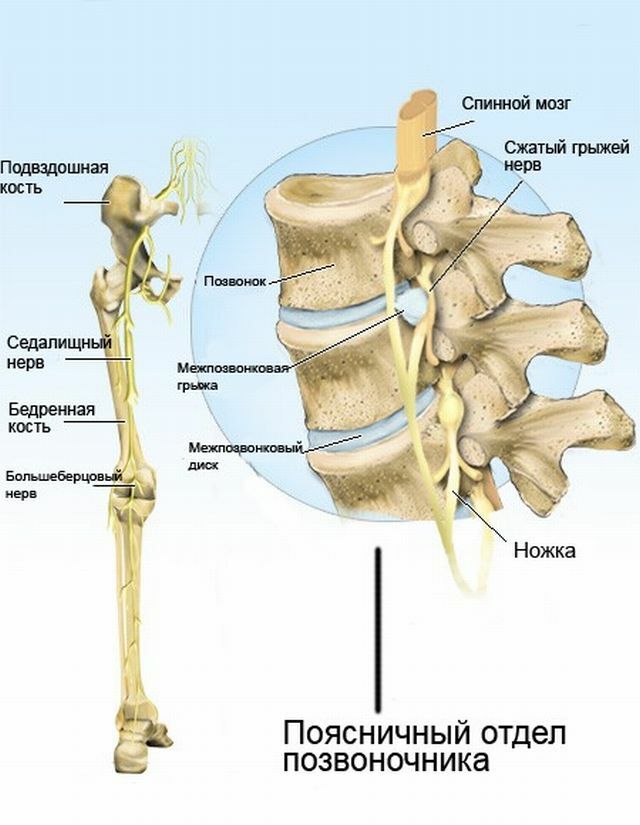
Anatomy and location of the sciatic nerve
Causes and triggers of sciatica
Neuropathy of the sciatic nerve or sciatica can be triggered by the following diseases and conditions:
- Appearance of of the intervertebral hernia .During this disturbance, the jelly nucleus of the disc exits beyond the fibrous ring, and the nerve root is squeezed. The main causes of herniation of the lumbar disc may be changes in the body of an age and degenerative nature, as well as traumatic injuries or sharp movements of the spine.
- Osteochondrosis , namely, dystrophic changes of intervertebral discs. These disorders lead to the drying of the pulpous nucleus, which leads to a decrease in the gap between the vertebrae. As a result, it provokes squeezing and inflammation of the sciatic nerve and develops neuritis.
- Narrowing of the spinal canal .The occurrence of spinal stenosis of the lumbar region occurs as a result of aging of the body. During this process, there is a proliferation of soft tissues, there is a weakness of the muscular corset, bulging of the intervertebral disc. All this leads to squeezing the nerve roots.

- Pregnancy period .In women, as a result of a sharp set of weight, there may be a shift in the center of gravity, as well as a variety of hormonal changes. All this leads to the appearance of sciatica. If during a pregnancy to perform certain physical exercises, neuralgia of the sciatic nerve does not arise.
- If the has an increased physical load on the spine , then there is a probability of appearance of sciatica.
- Ischialgia may appear as a result of of a sharp and prolonged hypothermia of the body .
- Sharp turns, back movements, traumatic injuries to the which can cause the displacement of the sciatic nerve. Even with a slight fracture of the vertebra, the body of one vertebra can slip from the other, as a result, it results in squeezing the nerve roots.
- The appearance of a spinal cord tumor can lead to sciatica nerve inflammation.
- Various viral lesions of the sciatic nerve.
- Various toxic poisonings - poisoning with arsenic, mercury, increased consumption of alcoholic beverages, improper administration of medicines near the ends of the sciatic nerve.
- Infectious lesions - influenza, tuberculosis, malaria, syphilis, scarlet fever, sepsis, abdominal and typhus.
Features of the clinical picture
The main symptom of neuralgia of the sciatic nerve or sciatica is the occurrence of severe pain. The pain is mainly localized in the lumbar region, buttocks, shins, sometimes it can move to the foot area. One-sided defeat is often observed. Painful sensations can last up to several days.
In addition to pain, other unpleasant symptoms of sciatica may appear: 
- the occurrence of difficulties in movement, especially when walking;
- may experience paresthesia or loss of sensitivity in the innervation zone;
- the appearance of stitching pains throughout the leg region;
- on the surface of the skin of the limb may appear a sensation of crawling craw;
- problems with flexion and extension of the knee, raising the leg;
- tension state of muscle fibers along the nerve;
- inability to control urination and defecation.
Symptoms of lumbago with sciatica
The main symptom of lumbago combined with sciatica( lumboschialgia) is the onset of severe pain. This 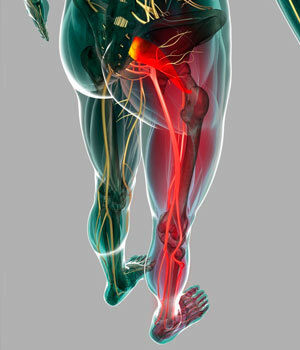 disorder can occur both in young adults and adults. Moreover, muscular spasms and lumbago can manifest themselves during heavy loads, or after them, also in the case of sharp temperature changes, for example in a hot sauna, bath or taking a cold shower.
disorder can occur both in young adults and adults. Moreover, muscular spasms and lumbago can manifest themselves during heavy loads, or after them, also in the case of sharp temperature changes, for example in a hot sauna, bath or taking a cold shower.
The main signs of lumboschialgia:
- The sciatic nerve is very painful. Pain can be of different nature - intense, tearing, impulsive, shooting character. At first, acute pain occurs, and it lasts about 30 minutes. The pain can subside and re-emerge. Pain can last about a week, but it may take almost a month to completely eliminate it.
- Muscle cramps( spasms) .The state of strong muscle tension arises from a pain syndrome.
- Decreased motor activity in the lumbar region of .Severe muscle spasms causes the patient to become immobilized. Any attempts to move can cause severe pain, especially in the lumbar region.
Diagnosis of
Diagnosis of sciatica is carried out in several ways. The most common option is radiography. The main advantage of this method is its simplicity and rapid conduct. In addition, this examination allows you to accurately determine the presence of sciatica nerve inflammation. But this method can not be used during pregnancy, restless patients and with obesity, since it will be practically impossible to make out the vertebrae in the pictures.
 Another method that allows you to accurately determine the presence of ischialgia is computer diagnosis. Computer diagnostics, unlike the first method, makes it possible to determine the presence of this disease most accurately. However, it is contraindicated for pregnant women.
Another method that allows you to accurately determine the presence of ischialgia is computer diagnosis. Computer diagnostics, unlike the first method, makes it possible to determine the presence of this disease most accurately. However, it is contraindicated for pregnant women.
Magnetic resonance imaging is the optimal diagnostic method that can determine the presence of sciatic nerve neuralgia.
It is usually used in cases where the inflammatory process occurs in the spinal cord, in its membranes and surrounding soft tissues. This method allows you to study the state of soft tissues. But this method is not allowed to be used in the presence of metal implants. With the help of MRI, you can identify the causes of sciatica, which can not be detected with computer diagnostics and radiography.
Medical care
Treatment of sciatica aims to achieve the following objectives:
- release of the compressed nerve endings;
- elimination of pain syndrome;
- getting rid of muscle spasms;
- improvement of the trophism of muscular and nervous tissues, metabolic processes;
- cleansing the structure of cells from harmful substances, toxins and toxins;
- recovery of the entire trunk of the spine, lower limbs and pelvic organs.
During treatment therapy of neuralgia of the sciatic nerve( ischialgia), a complex treatment is carried out, which consists of the application of the following methods - drug therapy, physiotherapy, exercises that can be performed independently at home.
The treatment of the sciatic nerve is performed using the following methods and preparations( in the form of blockades, injections, oral administration):
- is recommended for resting the patient, all loads should be kept to a minimum;
- should definitely take analgesics to reduce pain;
- are taken non-steroidal anti-inflammatory drugs that reduce the inflammatory process from the affected area, reduce the pressure of the nerve roots;
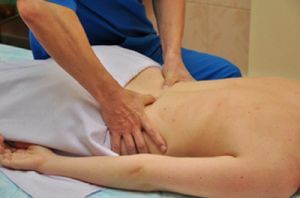
- additionally applies a manual effect, which is the decisive factor of all treatment therapy;
- acupuncture procedure;
- application of manual massage in the region of the waist, buttocks, thighs, drumstick and feet;
- use of reflexotherapy;
- conducting a course of medical gymnastics;
- additionally you can use ointments and preparations with a warming effect;
- treatment with the use of leeches - hirudotherapy;
- physiotherapy;
- water aerobics;
- Yoga classes.
Therapeutic blockade of the sciatic nerve with neuralgia:
Special exercises for sciatic nerve in sciatica that can be performed at home:
What can I do at home?
Treatment of neuralgia of the sciatic nerve is possible at home with the help of folk remedies and methods. The most effective effect in sciatica is provided by the following means:
- application of warm baths with the addition of bromine, sage, chamomile, sporicha;

- it is necessary to rub the diseased areas with the use of badger and bear fat;
- during the period of remission you can visit the baths and steamed with a birch broom;
- the inflamed area can be rubbed with beeswax in a melted form and tied with a bandage bandage;
- in the affected areas can be rubbed lavender oil, as well as St. John's wort oil or marjoram;
- it is possible to drink tea on the basis of birch leaves, elderberry, juniper;
- for salt removal, you can drink broths of parsley and dogrose, these herbs have a diuretic effect, which reduces edema and relieves pressure on the nerve roots.
Preventive measures
To avoid neuralgia, pinching or inflammation of the sciatic nerve, certain preventive measures should be observed:
- correction of posture disorders in childhood;
- prevention of asymmetry of the body with the help of manual therapy;
- exercising in reasonable limits, performing exercises aimed at strengthening the muscular corset;
- in the menu is worth including products with a high content of magnesium, calcium and other vitamins;
- tightening, performing exercises to strengthen the spine;
- weight lifting by the weightlifting method - the transfer of gravity to the limbs, while not transferring the load to the spine.
It is worth remembering that a constant sitting position can lead to weakening of the muscles, which as a result can become the main cause of severe consequences, in particular ischialgia. Therefore, from time to time, you need to perform exercises on tightening the muscles, strengthening the press, stretching. In addition, you must always monitor the condition of your posture.


